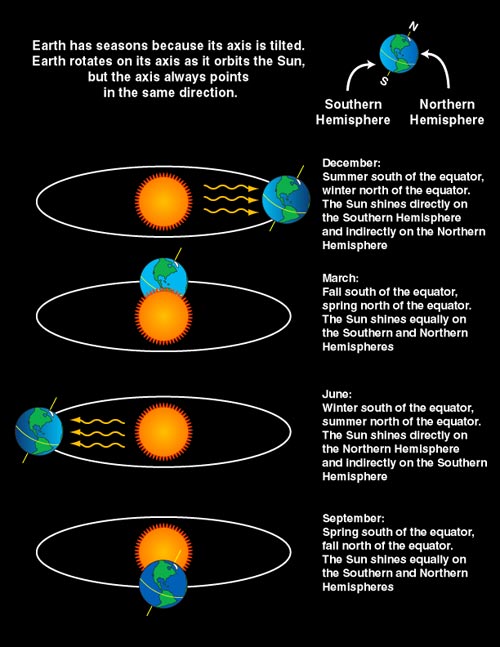What do you think?
Many people believe that Earth is closer to the sun in the summer and that is why it is hotter. And, likewise, they think Earth is farthest from the sun in the winter.
Although this idea makes sense, it is incorrect.
It is true that Earth’s orbit is not a perfect circle. It is a bit lop-sided. During part of the year, Earth is closer to the sun than at other times. However, in the Northern Hemisphere, we are having winter when Earth is closest to the sun and summer when it is farthest away! Compared with how far away the sun is, this change in Earth's distance throughout the year does not make much difference to our weather.
There is a different reason for Earth's seasons.
Earth's axis is an imaginary pole going right through the center of Earth from "top" to "bottom." Earth spins around this pole, making one complete turn each day. That is why we have day and night, and why every part of Earth's surface gets some of each.
Earth has seasons because its axis doesn't stand up straight. Long, long ago, when Earth was young, it is thought that something big hit Earth and knocked it off-kilter. So instead of rotating with its axis straight up and down, it leans over a bit.

By the way, that big thing that hit Earth is called Theia. It also blasted a big hole in the surface. That big hit sent a huge amount of dust and rubble into orbit. Most scientists think that that rubble, in time, became our Moon.
As Earth orbits the sun, its tilted axis always points in the same direction. So, throughout the year, different parts of Earth get the sun’s direct rays.

If you go to South America for the winter holidays, bring your swimsuit, not your skis!
Sometimes it is the North Pole tilting toward the sun (around June) and sometimes it is the South Pole tilting toward the sun (around December).
It is summer in June in the Northern Hemisphere because the sun's rays hit that part of Earth more directly than at any other time of the year. It is winter in December in the Northern Hemisphere, because that is when it is the South Pole's turn to be tilted toward the sun.
The seasons have an enormous effect on the living organisms and weather on our planet. Many animals and plants have adapted by changing behaviour or physically to survive these temperature changes. For example bears hibernate to avoid the cold winter when its difficult to find food and some birds migrate to warmer countries once their food supply disappears because of the cold weather.
Task: Separate a piece of paper into four quarters and title them Spring, Summer, Autumn and Winter. In each one list some of the things which happen to the weather, day length, animals and plants during that season. You can illustrate them too. I have set an assignment in Teams for you to send it to me.
Homework: What do the words solstice and equinox mean? Click on the link below and read the whole page. Then write a definition for each word and find out the dates of the each solstice and equinox. Bring them to science next week please. earthobservatory.nasa.gov/blogs/eokids/wp-content/uploads/sites/6/2019/04/16_SunSeasons-508.pdf